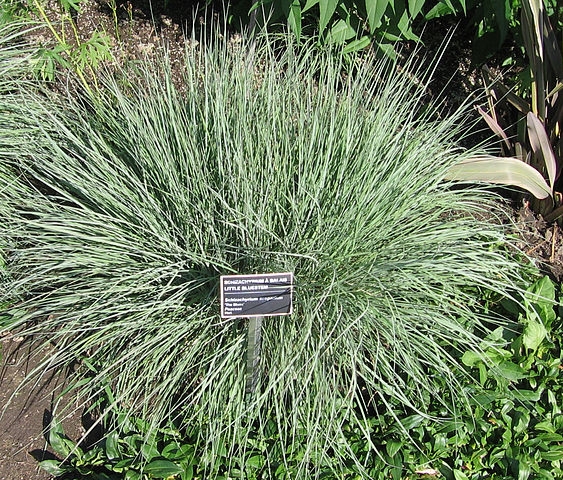Cabarrus Cooperative Extension Fall Plant Sale
go.ncsu.edu/readext?224655
en Español / em Português
El inglés es el idioma de control de esta página. En la medida en que haya algún conflicto entre la traducción al inglés y la traducción, el inglés prevalece.
Al hacer clic en el enlace de traducción se activa un servicio de traducción gratuito para convertir la página al español. Al igual que con cualquier traducción por Internet, la conversión no es sensible al contexto y puede que no traduzca el texto en su significado original. NC State Extension no garantiza la exactitud del texto traducido. Por favor, tenga en cuenta que algunas aplicaciones y/o servicios pueden no funcionar como se espera cuando se traducen.
Português
Inglês é o idioma de controle desta página. Na medida que haja algum conflito entre o texto original em Inglês e a tradução, o Inglês prevalece.
Ao clicar no link de tradução, um serviço gratuito de tradução será ativado para converter a página para o Português. Como em qualquer tradução pela internet, a conversão não é sensivel ao contexto e pode não ocorrer a tradução para o significado orginal. O serviço de Extensão da Carolina do Norte (NC State Extension) não garante a exatidão do texto traduzido. Por favor, observe que algumas funções ou serviços podem não funcionar como esperado após a tradução.
English
English is the controlling language of this page. To the extent there is any conflict between the English text and the translation, English controls.
Clicking on the translation link activates a free translation service to convert the page to Spanish. As with any Internet translation, the conversion is not context-sensitive and may not translate the text to its original meaning. NC State Extension does not guarantee the accuracy of the translated text. Please note that some applications and/or services may not function as expected when translated.
Collapse ▲All orders MUST BE PLACED ONLINE. We are not able to accept orders over the telephone or through the mail. Having trouble ordering? Call our office or check out our Troubleshooting Page.
Deadline to order is
Friday, October 31, 2025 at 5 p.m.
For questions, call 704-920-3310; weekdays; between 8 a.m. and 5 p.m.
ORDER HERE
BERRY PLANTS
All berry plants are sold in 1-gallon containers and are well adapted to the Piedmont growing conditions. Cost for plants is $10 each.
Blueberries
At least two different varieties of blueberries must be planted to ensure cross-pollination in order to produce fruit.
Climax: Rabbiteye blueberry, Early Season Producer. Likes acidic soil. Soil test recommended before planting. Requires more than one variety for pollination. Planting different cultivars will extend season. https://plants.ces.ncsu.edu/plants/vaccinium-virgatum
Premier: Rabbiteye blueberry, Early to Mid Season Producer. Likes acidic soil. Soil test recommended before planting. Self Pollinating. Planting different cultivars will extend season. https://plants.ces.ncsu.edu/plants/vaccinium-virgatum
Powder Blue: Rabbiteye blueberry, Late Season Producer. Likes acidic soil. Soil test recommended before planting. Requires more than one variety for pollination. Planting different cultivars will extend season. https://plants.ces.ncsu.edu/plants/vaccinium-virgatum
Alapaha: Medium-sized, dark blue berry which ripen in late May to early June. Developed at University of Georgia, it is named for the Alapaha (a-LAP-uh-ha) River in southern Georgia. Its combination of early ripening and late flowering makes it relatively frost hardy. https://plants.ces.ncsu.edu/plants/vaccinium-virgatum/
Blackberries
Natchez: Thornless blackberry. Early season. Erect canes. Elongated fruit.
https://content.ces.ncsu.edu/blackberries-for-the-home-garden
Apache: Thornless blackberry. Mid season. Erect canes. medium-size, portions of the fruit may turn white during hot weather. https://content.ces.ncsu.edu/blackberries-for-the-home-garden
Muscadines
Carlos: Standard to make white muscadine wine. It is a bronze self-fertile and contains 16% sugar. Very vigorous, yielding large amounts of quality, medium size fruit. Cold hardy and disease resistant.
https://plants.ces.ncsu.edu/plants/vitis-rotundifolia/
Doreen: Similar to Carlos, more disease resistance, similar berry quality, with a much later harvest and a less dry scar. Better fruit rot resistance.
https://plants.ces.ncsu.edu/plants/vitis-rotundifolia/
Tara: Bronze self fertile, large berry; harvest season is early. Relatively dry stem scar. Good fruit rot resistance and high yield. https://plants.ces.ncsu.edu/plants/vitis-rotundifolia/
Magnolia: Similar to Carlos but with smaller fruit size. Good for snacking or juice.
https://plants.ces.ncsu.edu/plants/vitis-rotundifolia/
Raspberries
Fall Gold: Self-fertile gold raspberry, the ability to produce two crops each season. After a late summer to fall harvest, a second crop arrives the following spring on the same canes. https://content.ces.ncsu.edu/raspberries-in-the-home-garden
Caroline: Self-fertile red raspberry, very productive, with a rich, full, and intense raspberry flavor. It is a very vigorous variety, with more tolerance for root rot. https://content.ces.ncsu.edu/raspberries-in-the-home-garden
Hops
Cascade: Spurred on by the demands of a burgeoning craft brewing industry and a strong public interest in locally grown ingredients; best variety for NC grown hops.
https://newcropsorganics.ces.ncsu.edu/specialty-crops/nc-hops/
FRUIT TREES
Elderberry
Adams: The Adams Elderberry is a striking deciduous perennial. The shrub is covered in dark green foliage that comes to a point and has serrated edges, and by June, the plant will be dotted by bunches of creamy white flowers. By late summer, the flowers give way to clusters of small dark blue to almost black fruit. https://plants.ces.ncsu.edu/plants/sambucus-canadensis/
Fig Trees
Fig trees come in 1-gallon containers. Cost per tree is $10.
Brown Turkey: Popular Fig cultivar. 10-30 feet tall. Self pollinating Harvest twice – spring and late summer. Cold hardy to 10 degrees. https://plants.ces.ncsu.edu/plants/ficus-carica-brown-turkey/
Celeste:Multi-branched shrub – most frequently grown figs. Pest and disease resistant but needs winter protection. It is heat tolerant and self-pollinating. https://plants.ces.ncsu.edu/plants/ficus-carica-celeste/
Black Mission: Uniquely-sweet taste and incredible texture set the Black Mission Fig apart, making it highly desirable for cooking and difficult to find at supermarkets. Dark purple fruit when ripe. https://plants.ces.ncsu.edu/plants/ficus-carica/
Pear Trees
Pear trees come in 5-gallon containers. Cost is $25 per tree.
Moonglow: The Moonglow pear tree is resistant to Fire Blight and can bear fruits for many years. It has a vigorous growth habit. Needs at least two cultivars to ensure adequate pollination. https://plants.ces.ncsu.edu/plants/pyrus-communis-moonglow/
Keiffer: Kieffer pear is a heavy bearing tree and can tolerate both drought and flooding. It is resistant to Fire Blight. At least two cultivars are recommended for adequate pollination. https://plants.ces.ncsu.edu/plants/pyrus-communis-kieffer/
Apple Trees
Apple trees come in 5-gallon containers. Cost is $25 per tree.
Jonagold: 5 Gallon – The Jonagold apple requires two other apple cultivars for pollination. The fruit is crimson red stippled with yellow-gold. Ripens in mid-September into October.
https://plants.ces.ncsu.edu/plants/malus-domestica-jonagold/
Fuji: Will produce red/pink apples in 3 to 5 years. Soil type needed is average to loamy but responds to enriched soil with better production. Most apple trees do best with a slightly acidic soil pH in the range of 5.0 to 6.8.https://plants.ces.ncsu.edu/plants/malus-domestica-fuji/
Gala: The Gala is a propagated apple cultivar, from the 1920s, with a mild, sweet, and sometimes slightly tart flavor. It is a popular apple for fresh eating, salads, and cooking. It is semi-dwarf, meaning its height reaches about 12 to 15 feet at maturity. https://plants.ces.ncsu.edu/plants/malus-domestica-gala/
Pomegranate Tree
Pomegranate trees come in 3-gallon containers. Cost is $25 per tree.
Dwarf: Compact shrub-like tree up to 3′. Needs to be planted in a protected area or in a container to overwinter. The plant will be killed to the ground at temperatures below 10 F.
https://plants.ces.ncsu.edu/plants/punica-granatum/
Pecan Tree
Pecan trees come in 5-gallon containers. Cost is $40 per tree.
Elliott: Hardy pecan widely planted in the Southeast. Resistant to scab. Small, teardrop-shaped nut of very good quality, usually in alternate years. 50 to 100 feet tall. Need at least two trees from two different cultivars. Type II pollinator. https://plants.ces.ncsu.edu/plants/carya-illinoinensis-elliot/
Kiowa: Noted for consistently producing a very large, high-quality nut. The quality of the nut, year-over-year, is good; however, it is subject to alternate bearing and in years with a high crop load, quality may drop off. It can also be easier to train this cultivar to have a central leader. High resistance to pecan scab. https://plants.ces.ncsu.edu/plants/carya-illinoinensis-kiowa/
Pawnee: Large nut size and early harvest (early Sept). Mature in 8-10 years at 25-30 ft. Good disease resistance, but nut scab can be a problem. Type I pollinator. Requires two other cultivars. https://plants.ces.ncsu.edu/plants/carya-illinoinensis-pawnee/
Peach Tree
Peach trees come in 5-gallon containers. Cost is $25 per tree.
Contender: Great cold-hardy cultivar that can adapt to temperature falls below zero. It is developed in Raleigh, NC. Self-pollinating with heavy bearing each year. https://plants.ces.ncsu.edu/plants/prunus-persica-contender/
Red Haven: Heavy-bearing cultivar with little maintenance, easy to grow. It has a spreading characteristic in branches. It is resistant to leaf-spot and self-pollinating. Adapted to cold climates as well. https://plants.ces.ncsu.edu/plants/prunus-persica-redhaven/
Plum Tree
Plum trees come in 5-gallon containers. Cost is $25 per tree.
Methley: Heavy bearing variety, start to produce fruit in 2-4 growing seasons. Susceptible to spring frost damage. Self fertile, but planting two cultivars is recommended. https://plants.ces.ncsu.edu/plants/prunus-salicina-methley/
Persimmon
Plum trees come in 5-gallon containers. Cost is $25 per tree.
American: Woody, deciduous tree native to the central and eastern United States and can reach 30 to 80 feet high and 20 to 35 feet wide. https://plants.ces.ncsu.edu/plants/diospyros-virginiana/
ORDER HERE
Native Perennials
Come in 1-gallon containers. Cost is $10 per plant.
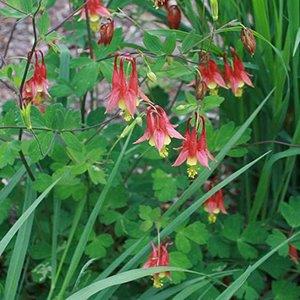 Aquilegia can. ‘Little Lanterns’ – Wild columbine prefers partial shade conditions but will tolerate more sun with adequate moisture. It prefers organically rich, moist soil like that in its native forest home. It may grow 3 feet tall by 1.5 feet wide. The red and yellow flowers mature in early spring and can last one month. These tubular flowers attract hummingbirds, butterflies, and bumblebees. https://plants.ces.ncsu.edu/plants/aquilegia-canadensis/
Aquilegia can. ‘Little Lanterns’ – Wild columbine prefers partial shade conditions but will tolerate more sun with adequate moisture. It prefers organically rich, moist soil like that in its native forest home. It may grow 3 feet tall by 1.5 feet wide. The red and yellow flowers mature in early spring and can last one month. These tubular flowers attract hummingbirds, butterflies, and bumblebees. https://plants.ces.ncsu.edu/plants/aquilegia-canadensis/
 Asclepias incarnata – This elegant plant is upright with slender willow like leaves. In summer plants are topped by rounded pink or rose colored flower clusters which attract flocks of butterflies. Plants thrive in sunny sites with moist or saturated soils. https://plants.ces.ncsu.edu/plants/asclepias-incarnata/
Asclepias incarnata – This elegant plant is upright with slender willow like leaves. In summer plants are topped by rounded pink or rose colored flower clusters which attract flocks of butterflies. Plants thrive in sunny sites with moist or saturated soils. https://plants.ces.ncsu.edu/plants/asclepias-incarnata/
 Aster Oblongifolium ‘Radon’s Favorite’ – Aster –Plant in the full sun with well drained soil. Reaching a mature height and width of 3 feet aromatic aster creates dense low mounds. – https://plants.ces.ncsu.edu/plants/symphyotrichum-oblongifolium/
Aster Oblongifolium ‘Radon’s Favorite’ – Aster –Plant in the full sun with well drained soil. Reaching a mature height and width of 3 feet aromatic aster creates dense low mounds. – https://plants.ces.ncsu.edu/plants/symphyotrichum-oblongifolium/
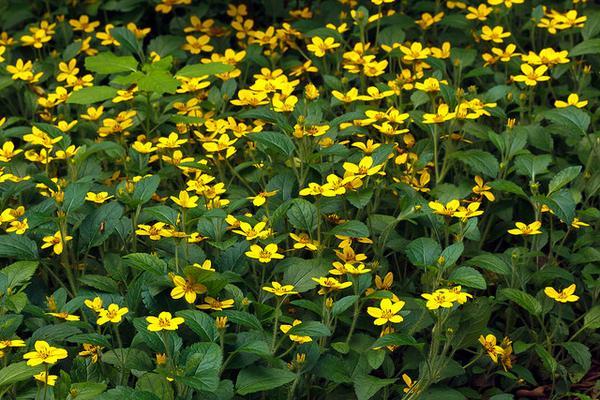 Chrysogonum virginianum Green & Gold a rhizomatous, low-growing herbaceous perennial which typically forms an easily-controlled foliage mat 1″-2″ tall while spreading to 18″ wide or more as a shady ground cover.
Chrysogonum virginianum Green & Gold a rhizomatous, low-growing herbaceous perennial which typically forms an easily-controlled foliage mat 1″-2″ tall while spreading to 18″ wide or more as a shady ground cover.
https://plants.ces.ncsu.edu/plants/chrysogonum-virginianum/
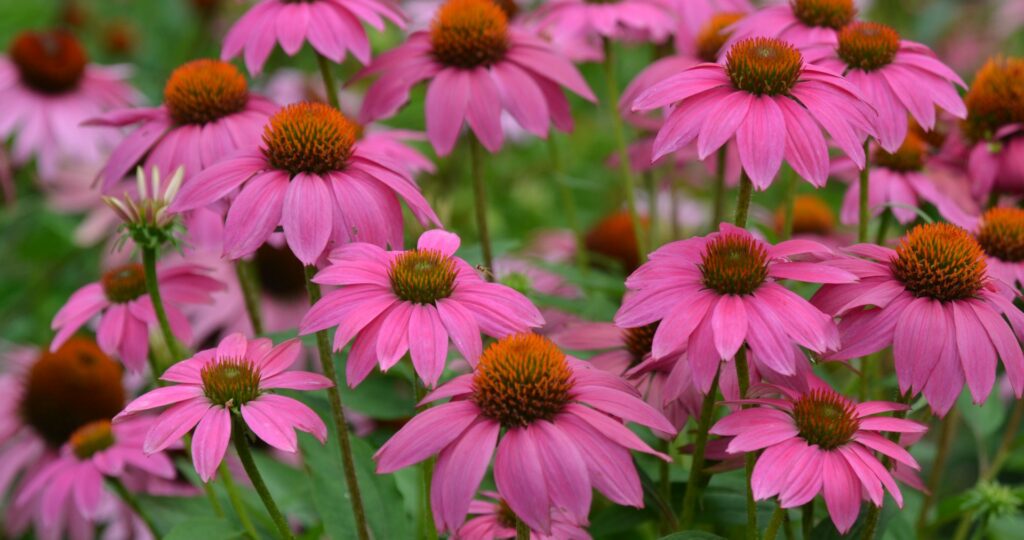 Echinacea purpurea – Coneflower ‘PowWow Wildberry’- A vibrant variety of coneflower will bring a pop to your native garden. They are heat and drought resistant, easy to grow, bloom for months, make great cut flowers, and attract birds and pollinators. https://plants.ces.ncsu.edu/plants/echinacea-purpurea/
Echinacea purpurea – Coneflower ‘PowWow Wildberry’- A vibrant variety of coneflower will bring a pop to your native garden. They are heat and drought resistant, easy to grow, bloom for months, make great cut flowers, and attract birds and pollinators. https://plants.ces.ncsu.edu/plants/echinacea-purpurea/
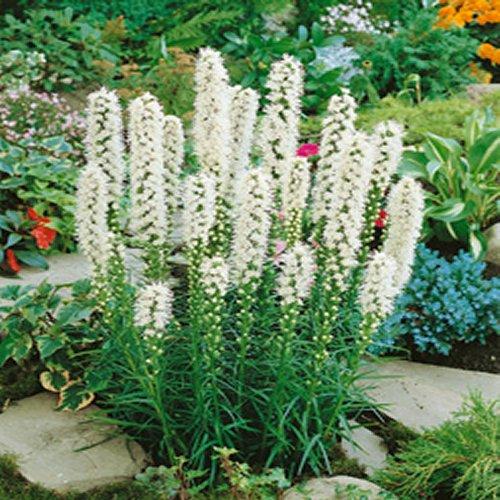 Liatris spicata ‘Alba’ – Blazing Star – White variety of liatris – same clump-forming perennial that typically grows 3 to 6 feet tall. The tall spikes of flowers bloom from the top down, are showy and attract pollinators. The foliage is grass-like and grows in clumps. https://plants.ces.ncsu.edu/plants/liatris-spicata/
Liatris spicata ‘Alba’ – Blazing Star – White variety of liatris – same clump-forming perennial that typically grows 3 to 6 feet tall. The tall spikes of flowers bloom from the top down, are showy and attract pollinators. The foliage is grass-like and grows in clumps. https://plants.ces.ncsu.edu/plants/liatris-spicata/
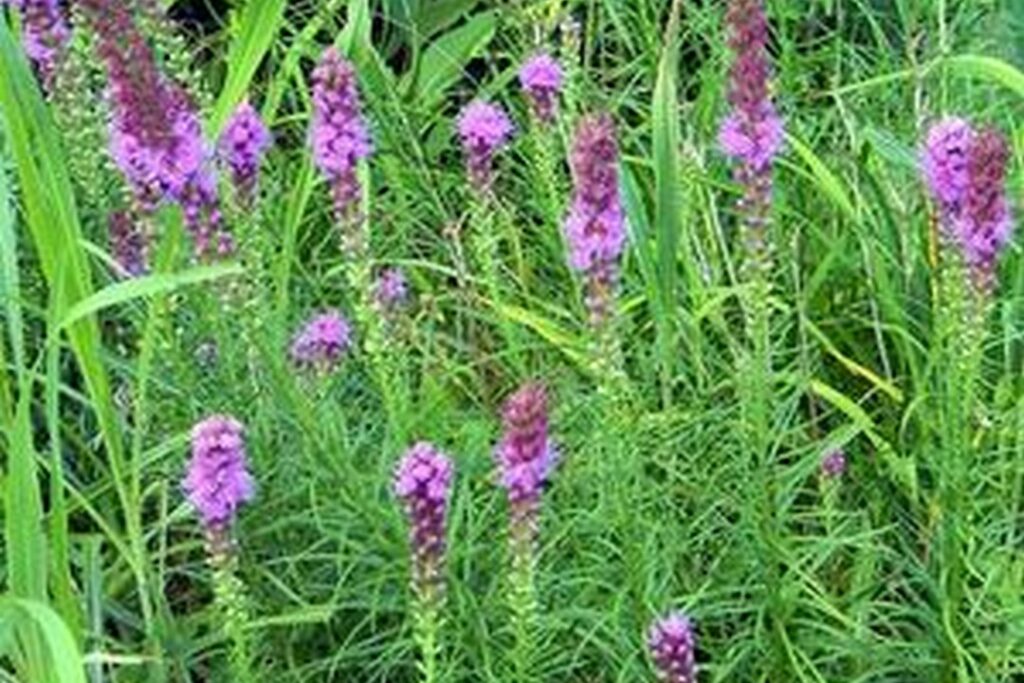 Liatris spicata – Blazing Star – clump-forming perennial that typically grows 3 to 6 feet tall. The tall spikes of flowers bloom from the top down, are showy and attract pollinators. The foliage is grass-like and grows in clumps. https://plants.ces.ncsu.edu/plants/liatris-spicata/
Liatris spicata – Blazing Star – clump-forming perennial that typically grows 3 to 6 feet tall. The tall spikes of flowers bloom from the top down, are showy and attract pollinators. The foliage is grass-like and grows in clumps. https://plants.ces.ncsu.edu/plants/liatris-spicata/
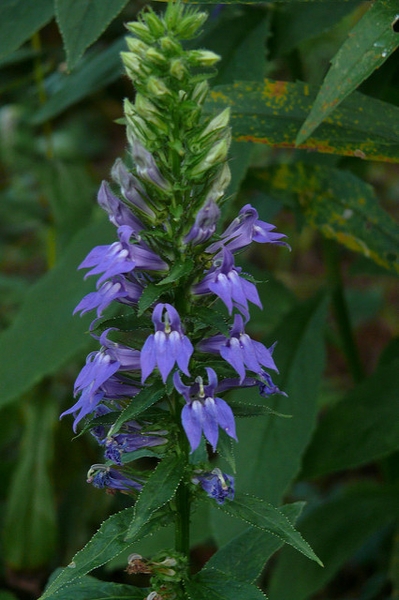 Lobelia siphilitica – Great Blue Lobelia is a herbaceous perennial that may grow 3 to 4 feet tall. The leaves are alternate with a toothed margin. Blue flowers first mature in mid-summer and continue into early fall. The flowers are larger than other Lobelias and have stripes on the tube portion.
Lobelia siphilitica – Great Blue Lobelia is a herbaceous perennial that may grow 3 to 4 feet tall. The leaves are alternate with a toothed margin. Blue flowers first mature in mid-summer and continue into early fall. The flowers are larger than other Lobelias and have stripes on the tube portion.
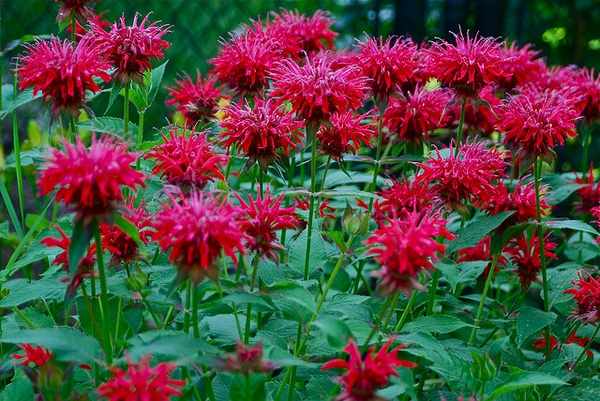
Monarda didyma ‘Jacob Cline’, Bee balm is an herbaceous perennial in the Lamiaceae (mint) family. Large red flowers. Fair amount of resistance to downy mildew. Prefers moist, well-drained soils and full sun; will tolerate some shade. Max height 4 feet. https://plants.ces.ncsu.edu/plants/monarda-didyma/
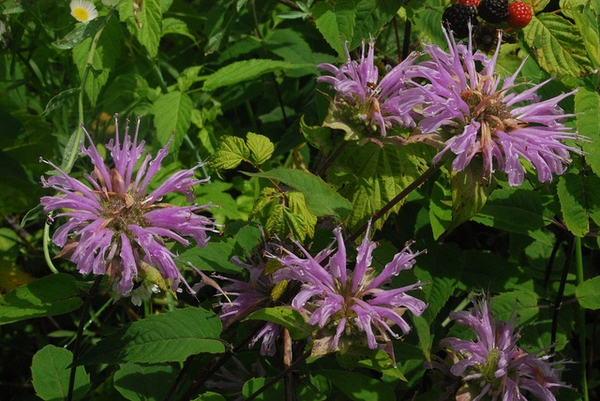 Monarda fistulosum Bee balm is an herbaceous perennial in the Lamiaceae (mint) family. Wild bergamot is a clumping plant that typically grows 2 to 4 feet tall. It performs best in full sun and moderately moist soils https://plants.ces.ncsu.edu/plants/monarda-fistulosa/
Monarda fistulosum Bee balm is an herbaceous perennial in the Lamiaceae (mint) family. Wild bergamot is a clumping plant that typically grows 2 to 4 feet tall. It performs best in full sun and moderately moist soils https://plants.ces.ncsu.edu/plants/monarda-fistulosa/
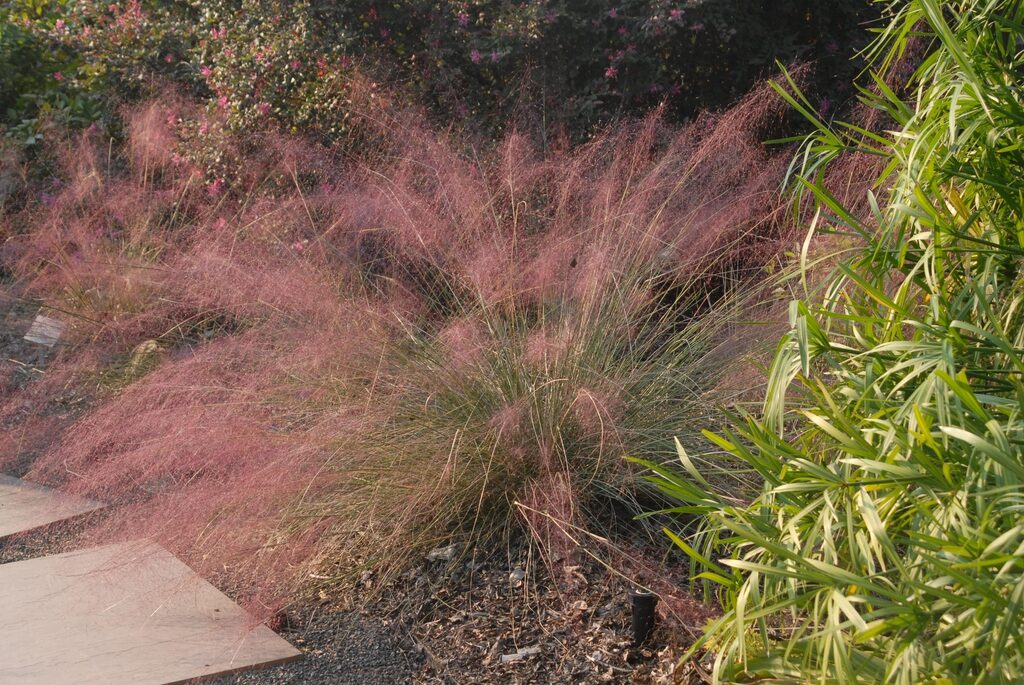 Muhlenbergia capillaris Easy-to-grow grass, unfussy about soil type, as long as it is well-drained. Plenty of sunshine. Tolerates heat, humidity, drought, and poor soil and is highly salt-tolerant. Absolute showstopper source of late-season color.
Muhlenbergia capillaris Easy-to-grow grass, unfussy about soil type, as long as it is well-drained. Plenty of sunshine. Tolerates heat, humidity, drought, and poor soil and is highly salt-tolerant. Absolute showstopper source of late-season color.
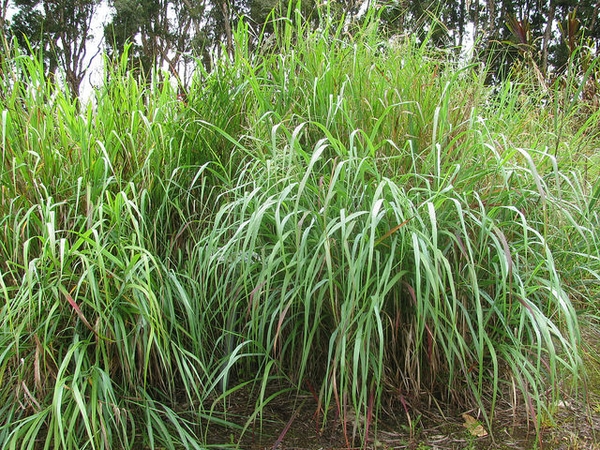 Panicum virgatum – Switchgrass – Perennial, warm-season ornamental. Reaches 3-4 feet and with its flower plumes it can measure up to 7 feet tall. It forms a dense columnar foliage clump that can spread slowly. https://plants.ces.ncsu.edu/plants/panicum-virgatum/
Panicum virgatum – Switchgrass – Perennial, warm-season ornamental. Reaches 3-4 feet and with its flower plumes it can measure up to 7 feet tall. It forms a dense columnar foliage clump that can spread slowly. https://plants.ces.ncsu.edu/plants/panicum-virgatum/
 Phlox divaricata ‘Blue Moon’ – A long-lived, carefree native groundcover. Bears many fragrant, 5-petaled flowers with the arrival of spring. https://plants.ces.ncsu.edu/plants/phlox-divaricata/
Phlox divaricata ‘Blue Moon’ – A long-lived, carefree native groundcover. Bears many fragrant, 5-petaled flowers with the arrival of spring. https://plants.ces.ncsu.edu/plants/phlox-divaricata/
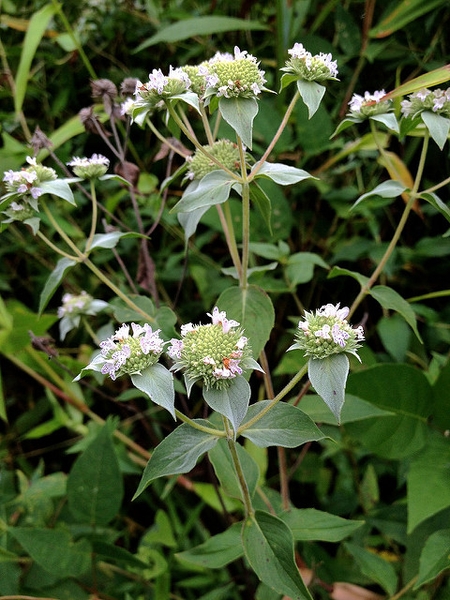 Pycnanthemum muticum- Blunt Mountain Mint is a native perennial in the mint family. It is commonly found in woodland areas and thickets and it prefers moist to medium well-drained soil. The leaves emit a strong spearmint fragrance when crushed. https://plants.ces.ncsu.edu/plants/pycnanthemum-muticum/
Pycnanthemum muticum- Blunt Mountain Mint is a native perennial in the mint family. It is commonly found in woodland areas and thickets and it prefers moist to medium well-drained soil. The leaves emit a strong spearmint fragrance when crushed. https://plants.ces.ncsu.edu/plants/pycnanthemum-muticum/
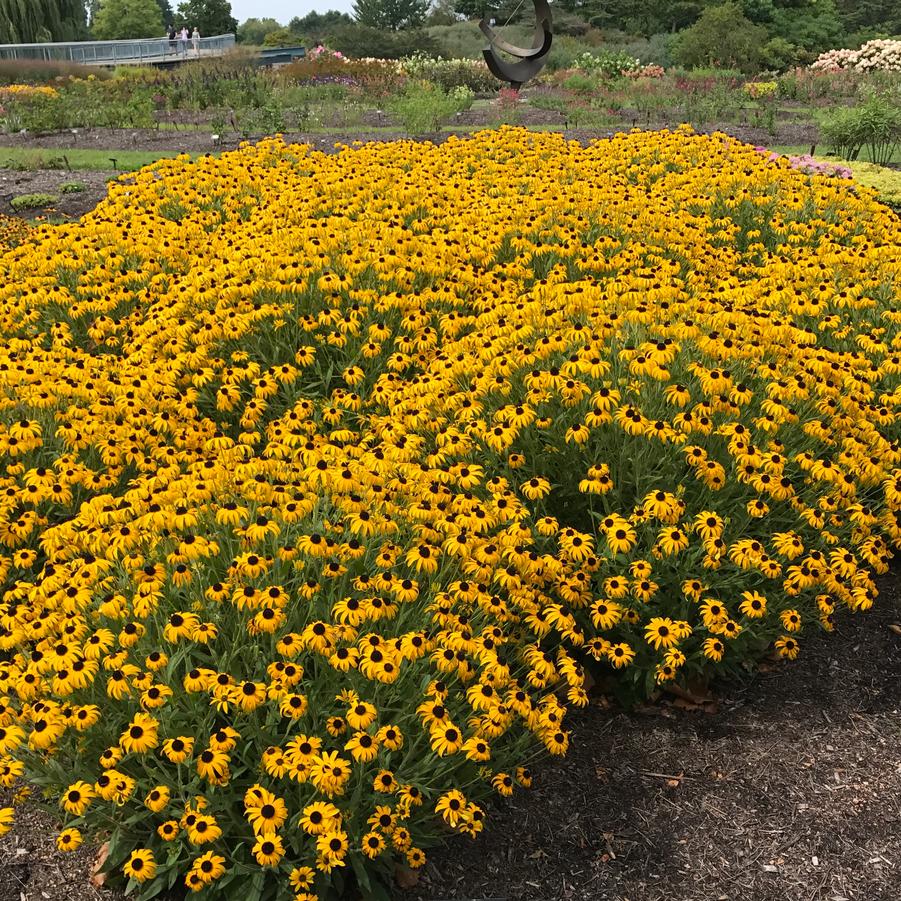 Rudbeckia fulgida var. ‘American Goldrush‘ – Knee-high compact tidy clump, with copious floral display and dwarf habit with increased manageability. https://plants.ces.ncsu.edu/plants/rudbeckia-fulgida/
Rudbeckia fulgida var. ‘American Goldrush‘ – Knee-high compact tidy clump, with copious floral display and dwarf habit with increased manageability. https://plants.ces.ncsu.edu/plants/rudbeckia-fulgida/
Schizachryium scop. ‘Standing Ovation’ – Ornamental Grass – Little Bluestem Easily grown, tolerates a wide range of soil conditions in full sun. https://plants.ces.ncsu.edu/plants/schizachyrium-scoparium/

Solidago rigida -Plants form a bushy, upright clump reaching 2 to 3 feet tall and wide of dark-green leaves and grow best in moist, well-drained soil, but are somewhat tolerant of dry and wet soils. https://www.wildflower.org/plants/result.php?id_plant=olrir
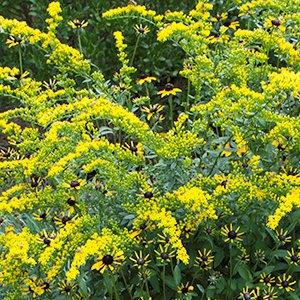 Solidago shortii – Goldenrod ‘Solar Cascade’ is a cultivar of Short’s Goldenrod developed by the Cincinnati Zoo Botanical Garden Native Endangered Plant Program as part of its efforts to save the species. https://plants.ces.ncsu.edu/plants/solidago-shortii
Solidago shortii – Goldenrod ‘Solar Cascade’ is a cultivar of Short’s Goldenrod developed by the Cincinnati Zoo Botanical Garden Native Endangered Plant Program as part of its efforts to save the species. https://plants.ces.ncsu.edu/plants/solidago-shortii
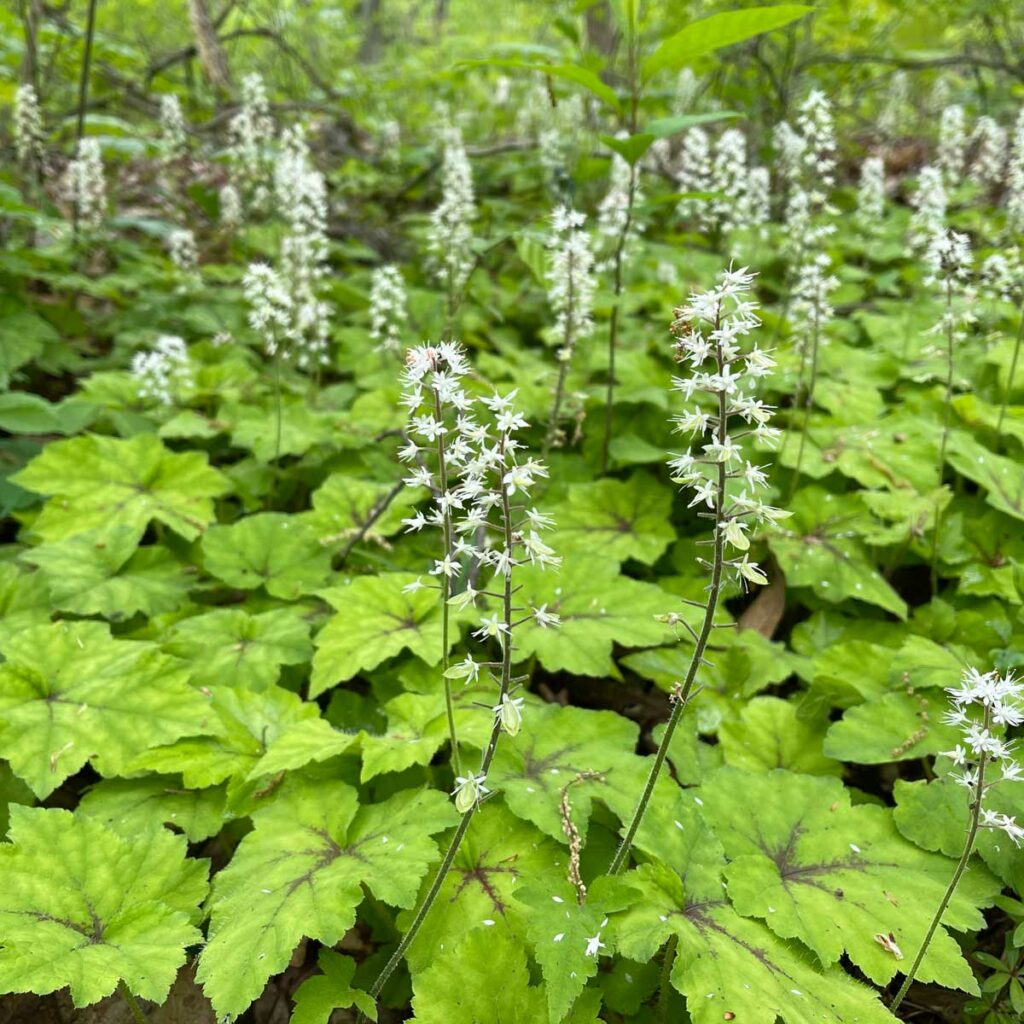 Tiarella cordifolia– Heart Leaf Foamflowerde’ small, delicate native herbaceous perennial flower grown in gardens for its neat, interesting foliage and small spikes of creamy white flowers. Slow growth rate, good groundcover for the heavy shade, https://plants.ces.ncsu.edu/plants/tiarella-cordifolia/
Tiarella cordifolia– Heart Leaf Foamflowerde’ small, delicate native herbaceous perennial flower grown in gardens for its neat, interesting foliage and small spikes of creamy white flowers. Slow growth rate, good groundcover for the heavy shade, https://plants.ces.ncsu.edu/plants/tiarella-cordifolia/





